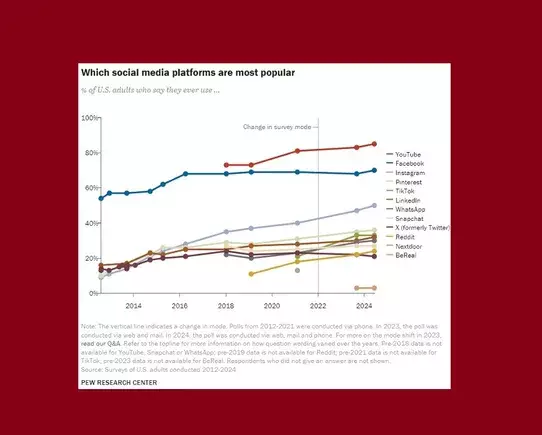The social media landscape is constantly changing, reflecting shifts in user behavior, platform popularity, and engagement strategies. Recently, Pew Research Center released its latest analysis of social media usage in the United States, shedding light on emerging trends that could dictate the future of digital communication. This survey, which included 5,626 adult participants from February 1 to June 10 of this year, provides a snapshot of online engagement and posits compelling questions about the relevance of various platforms, particularly the platform formerly known as Twitter, now rebranded as X.
According to the Pew report, YouTube remains the frontrunner in social media usage, defying traditional categorizations of social platforms. While it excels primarily as a video-sharing site, many still consider it a social app due to its vast user engagement and community building features. The survey indicates that a significant number of Americans consistently use YouTube. However, it raises the question: can it truly be equated with platforms like Facebook and Instagram, which are fundamentally designed for interaction? The definition of “social media” is evolving, and YouTube’s predominance suggests that video consumption could grapple with user engagement for social interaction, blurring the lines between entertainment and socializing.
Facebook and Instagram: Resilience amid Competition
Facebook and Instagram continue to hold strong positions, appealing especially to specific demographics. Particularly, Facebook has maintained its relevance among older adults, serving as a vital tool for connection and communication. Instagram, with its visually driven content, appeals to a younger audience and keeps its status intact among the most-used apps. The sustained popularity of these platforms emphasizes the importance of understanding user demographics. The evolving preferences warrant a careful look at target audience profiles and how brands adapt their strategies accordingly.
Pew’s findings indicate a slight decline in the usage of X; however, the fall is more subtle than anticipated. This observation raises an interesting discussion point: while some predict a steep drop, the reality suggests a more resilient user base. Instead of a mass exodus, X appears to be experiencing a natural ebb and flow, which may not necessarily foreshadow its demise, but rather a shift in user priorities. Many users are likely to explore other platforms, yet those who gravitate towards X still find value in its offerings.
Emerging Competitors: TikTok and Beyond
Interestingly, Pew’s data reveals that TikTok usage has plateaued over the past year. This stagnation challenges the narrative of relentless growth associated with this platform. Contrastingly, Pinterest and other platforms like LinkedIn and Reddit have seen slight increases in user engagement, suggesting a diversification in content and platform preference. The rise of Pinterest, for instance, signals that niche visual platforms are carving out their space within the social media arena, appealing to users in ways distinct from traditional social media interactions.
Navigating through various user demographics reveals that each platform attracts different age groups. Facebook remains a favored choice among older adults, while TikTok and Snapchat enthrall younger users. This demographic specificity impacts marketing and engagement strategies significantly. Successful brands and businesses will be those that not only recognize these distinctions but also adapt their content and engagement approaches accordingly. It’s crucial to meet your audience where they are and leverage these insights to fine-tune outreach efforts, particularly as future trends unfold.
The insights provided by the Pew Research survey present a critical overview of current social media trends, laying groundwork for strategic planning in the coming years. While platforms like YouTube, Facebook, and Instagram continue to hold sway, emerging players and slight declines in engagement challenge the status quo. It is imperative for marketers, brands, and content creators to analyze these trends meticulously and pivot their strategies as needed to remain relevant. Understanding audience behavior and preferences will be the cornerstone for navigating the ever-evolving landscape of social media in 2025 and beyond.


Leave a Reply